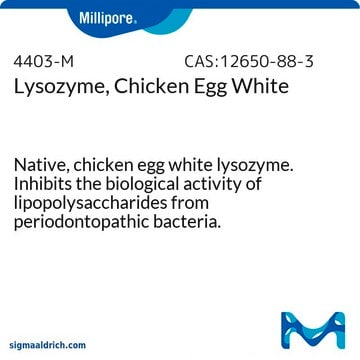This product is supplied by the ATCC. The growth phase at the time of harvest is not reported by the supplier. In general, in order to maximize production and viability, cells are in log phase or beginning stationary phase at the time of harvest.
M3770
Micrococcus lysodeikticus ATCC No. 4698
suitable for substrate for the assay of lysozyme, lyophilized cells
Synonym(s):
Micrococcus luetus
Select a Size
$93.60
List Price$104.00Save 10%In StockDetails
Select a Size
About This Item
$93.60
List Price$104.00Save 10%In StockDetails
Recommended Products
form
lyophilized cells
Quality Level
suitability
suitable for substrate for the assay of lysozyme
storage temp.
−20°C
Application
Biochem/physiol Actions
Quality
Unit Definition
Storage Class
11 - Combustible Solids
wgk_germany
WGK 3
flash_point_f
Not applicable
flash_point_c
Not applicable
ppe
Eyeshields, Gloves, type N95 (US)
Choose from one of the most recent versions:
Certificates of Analysis (COA)
Don't see the Right Version?
If you require a particular version, you can look up a specific certificate by the Lot or Batch number.
Already Own This Product?
Find documentation for the products that you have recently purchased in the Document Library.
Customers Also Viewed
Protocols
To measure achromopeptidase activity, this procedure uses bacterial cells and a turbidimetric rate assay. Turbidity is measured at 600 nm using a spectrophotometer.
This enzymatic rate determination may be used for Lysozyme products. It is not to be used to assay recombinant or insoluble Lysozyme on agarose.
-
From which growth phase are the bacteria harvested?
1 answer-
Helpful?
-
Active Filters
Our team of scientists has experience in all areas of research including Life Science, Material Science, Chemical Synthesis, Chromatography, Analytical and many others.
Contact Technical Service







